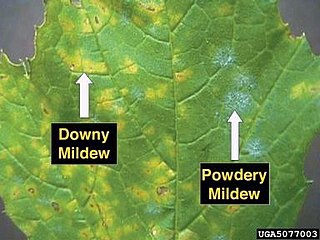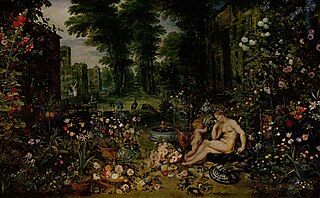
In organic chemistry, a ketone is an organic compound with the structure R−C(=O)−R', where R and R' can be a variety of carbon-containing substituents. Ketones contain a carbonyl group −C(=O)−. The simplest ketone is acetone, with the formula (CH3)2CO. Many ketones are of great importance in biology and industry. Examples include many sugars (ketoses), many steroids, and the solvent acetone.

In organic chemistry, a thiol, or thiol derivative, is any organosulfur compound of the form R−SH, where R represents an alkyl or other organic substituent. The −SH functional group itself is referred to as either a thiol group or a sulfhydryl group, or a sulfanyl group. Thiols are the sulfur analogue of alcohols, and the word is a blend of "thio-" with "alcohol".
Body odor or body odour (BO) is present in all animals and its intensity can be influenced by many factors. Body odor has a strong genetic basis, but can also be strongly influenced by various factors, such as sex, diet, health, and medication. The body odor of human males plays an important role in human sexual attraction, as a powerful indicator of MHC/HLA heterozygosity. Significant evidence suggests that women are attracted to men whose body odor is different from theirs, indicating that they have immune genes that are different from their own, which may produce healthier offspring.

Powdery mildew is a fungal disease that affects a wide range of plants. Powdery mildew diseases are caused by many different species of ascomycete fungi in the order Erysiphales. Powdery mildew is one of the easier plant diseases to identify, as the signs of the causal pathogen are quite distinctive. Infected plants display white powdery spots on the leaves and stems. This mycelial layer may quickly spread to cover all of the leaves. The lower leaves are the most affected, but the mildew can appear on any above-ground part of the plant. As the disease progresses, the spots get larger and denser as large numbers of asexual spores are formed, and the mildew may spread up and down the length of the plant.

An aroma compound, also known as an odorant, aroma, fragrance or flavoring, is a chemical compound that has a smell or odor. For an individual chemical or class of chemical compounds to impart a smell or fragrance, it must be sufficiently volatile for transmission via the air to the olfactory system in the upper part of the nose. As examples, various fragrant fruits have diverse aroma compounds, particularly strawberries which are commercially cultivated to have appealing aromas, and contain several hundred aroma compounds.

Androstenone (5α-androst-16-en-3-one) is a 16-androstene class steroidal pheromone. It is found in boar's saliva, celery cytoplasm, and truffle fungus. Androstenone was the first mammalian pheromone to be identified. It is found in high concentrations in the saliva of male pigs, and, when inhaled by a female pig that is in heat, results in the female assuming the mating stance. Androstenone is the active ingredient in 'Boarmate', a commercial product made by DuPont sold to pig farmers to test sows for timing of artificial insemination.
In horticulture, lime sulfur (lime sulphur in British English, see American and British English spelling differences) is mainly a mixture of calcium polysulfides and thiosulfate (plus other reaction by-products as sulfite and sulfate) formed by reacting calcium hydroxide with elemental sulfur, used in pest control. It can be prepared by boiling in water a suspension of poorly soluble calcium hydroxide (lime) and solid sulfur together with a small amount of surfactant to facilitate the dispersion of these solids in water. After elimination of residual solids (flocculation, decantation, and filtration), it is normally used as an aqueous solution, which is reddish-yellow in colour and has a distinctive offensive odor of hydrogen sulfide (H2S, rotten eggs).

Uncinula necator is a fungus that causes powdery mildew of grape. It is a common pathogen of Vitis species, including the wine grape, Vitis vinifera. The fungus is believed to have originated in North America. European varieties of Vitis vinifera are more or less susceptible to this fungus. Uncinula necator infects all green tissue on the grapevine, including leaves and young berries. It can cause crop loss and poor wine quality if untreated. The sexual stage of this pathogen requires free moisture to release ascospores from its cleistothecia in the spring. However, free moisture is not needed for secondary spread via conidia; high atmospheric humidity is sufficient. Its anamorph is called Oidium tuckeri.

Methyl vinyl ketone (MVK, IUPAC name: butenone) is the organic compound with the formula CH3C(O)CH=CH2. It is a reactive compound classified as an enone, in fact the simplest example thereof. It is a colorless, flammable, highly toxic liquid with a pungent odor. It is soluble in water and polar organic solvents. It is a useful intermediate in the synthesis of other compounds.

Erysiphales are an order of ascomycete fungi. The order contains one family, Erysiphaceae. Many of them cause plant diseases called powdery mildew.

1-Octen-3-ol, octenol for short and also known as mushroom alcohol, is a chemical that attracts biting insects such as mosquitoes. It is contained in human breath and sweat, and it is believed that insect repellent DEET works by blocking the insects' octenol odorant receptors.

Uncinula is a genus of fungi. Its species are plant pathogens that cause powdery mildew diseases on various plant hosts. The genus is characterized by its dark chasmothecia which bear filamentous, hyaline appendages with hooked tips. Over one hundred species have been described from mostly dicotyledenous hosts. Braun and Takamatsu (2000) suggested that Uncinula should be considered a later synonym of Erysiphe; not all subsequent researchers have accepted their conclusions.

An odor or odour is a smell or a scent caused by one or more volatilized chemical compounds generally found in low concentrations that humans and many animals can perceive via their olfactory system. While smell can refer to pleasant and unpleasant odors, the terms scent, aroma, and fragrance are usually reserved for pleasant-smelling odors and are frequently used in the food and cosmetic industry to describe floral scents or to refer to perfumes.

The sense of smell, or olfaction, is the special sense through which smells are perceived. The sense of smell has many functions, including detecting desirable foods, hazards, and pheromones, and plays a role in taste.
2-Methylundecanal is an organic compound that is found naturally in kumquat peel oil. This compound smells herbaceous, orange, and ambergris-like. At high dilution it has a flavor similar to honey and nuts. It is a colorless or pale yellow liquid that is soluble in organic solvents such as ether and ethanol. It is used as a fragrance component in soaps, detergents, and perfumes.
Synthetic musks are a class of synthetic aroma compounds to emulate the scent of deer musk and other animal musks. Synthetic musks have a clean, smooth and sweet scent lacking the fecal notes of animal musks. They are used as flavorings and fixatives in cosmetics, detergents, perfumes and foods, supplying the base note of many perfume formulas. Most musk fragrance used in perfumery today is synthetic.
Old person smell is the characteristic odor of elderly humans. Like many other animal species, human odor undergoes distinct stages based on chemical changes initiated through the aging process. Research suggests that this enables humans to determine the suitability of potential partners based on age, in addition to other factors.

6-Nonenal is an organic compound with the formula C2H5CH=CH(CH2)4CHO. Other isomeric nonenal compounds are also known to exist naturally, e.g. 2-nonenal. The cis-isomer of 6-nonenal is often listed as the principal component in the aromas of muskmelon fruits. The trans-isomer is listed as an off-flavor aroma of milk foams, and thought to be a possible polypropylene odorant.
trans-4,5-Epoxy-(E)-2-decenal is an oxygenated α,β-unsaturated aldehyde found in mammalian blood that gives blood its characteristic metallic odor. It is used by predators to locate blood or prey. Humans can smell it at a concentration of 1.5 pg/L in air, at 15 ng/L in water and 1.3μg/L in oil. It was permitted as a food flavouring in the EU until it was prohibited on 11 July 2017 on the grounds of possible genotoxicity, as observed from rat livers.
Trunk injection or endotherapy also known as vegetative endotherapy, is a method of target-precise application of pesticides, plant resistance activators, or fertilizers into the xylem vascular tissue of a tree with the purpose of protecting the tree from pests, or to inject nutrients to correct for nutrient deficiencies. This method largely relies on harnessing the tree's vascular system to translocate and distribute the active compounds into the wood, canopy and roots where protection or nutrition is needed.

















